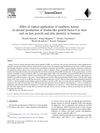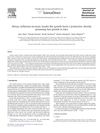Promotion of Insulin-Like Growth Factor-I Production by Sensory Neuron Stimulation: Molecular Mechanisms and Therapeutic Implications
December 2008
in “
Current medicinal chemistry
”
TLDR Stimulating sensory neurons can increase IGF-I production, which may help treat various diseases and improve tissue health.
The document from December 1, 2008, discusses the role of Insulin-like growth factor-I (IGF-I) in cellular processes and tissue integrity, and how its local production in tissues is increased by sensory neuron stimulation. The study found that capsaicin, a component that stimulates sensory neurons, elevates IGF-I and its mRNA levels in various organs through the release of calcitonin gene-related peptide (CGRP). This mechanism reduces liver injury by preventing apoptosis in mice. Additionally, isoflavone, a phytoestrogen, boosts CGRP production, which in turn promotes IGF-I production in hair follicles, aiding hair growth in mice and human volunteers with alopecia. Topical capsaicin application also enhances dermal IGF-I levels and facial skin elasticity in humans. The research also notes that spontaneously hypertensive rats (SHR) have lower CGRP and IGF-I levels than normotensive rats, which contributes to hypertension and other health issues. Capsaicin administration in SHRs elevates CGRP and IGF-I to normal levels and normalizes blood pressure. The findings suggest that pharmacological stimulation of sensory neurons to increase tissue IGF-I levels could be a new therapeutic approach for various diseases, offering an alternative to direct GH or IGF-I administration, which can have adverse effects.





